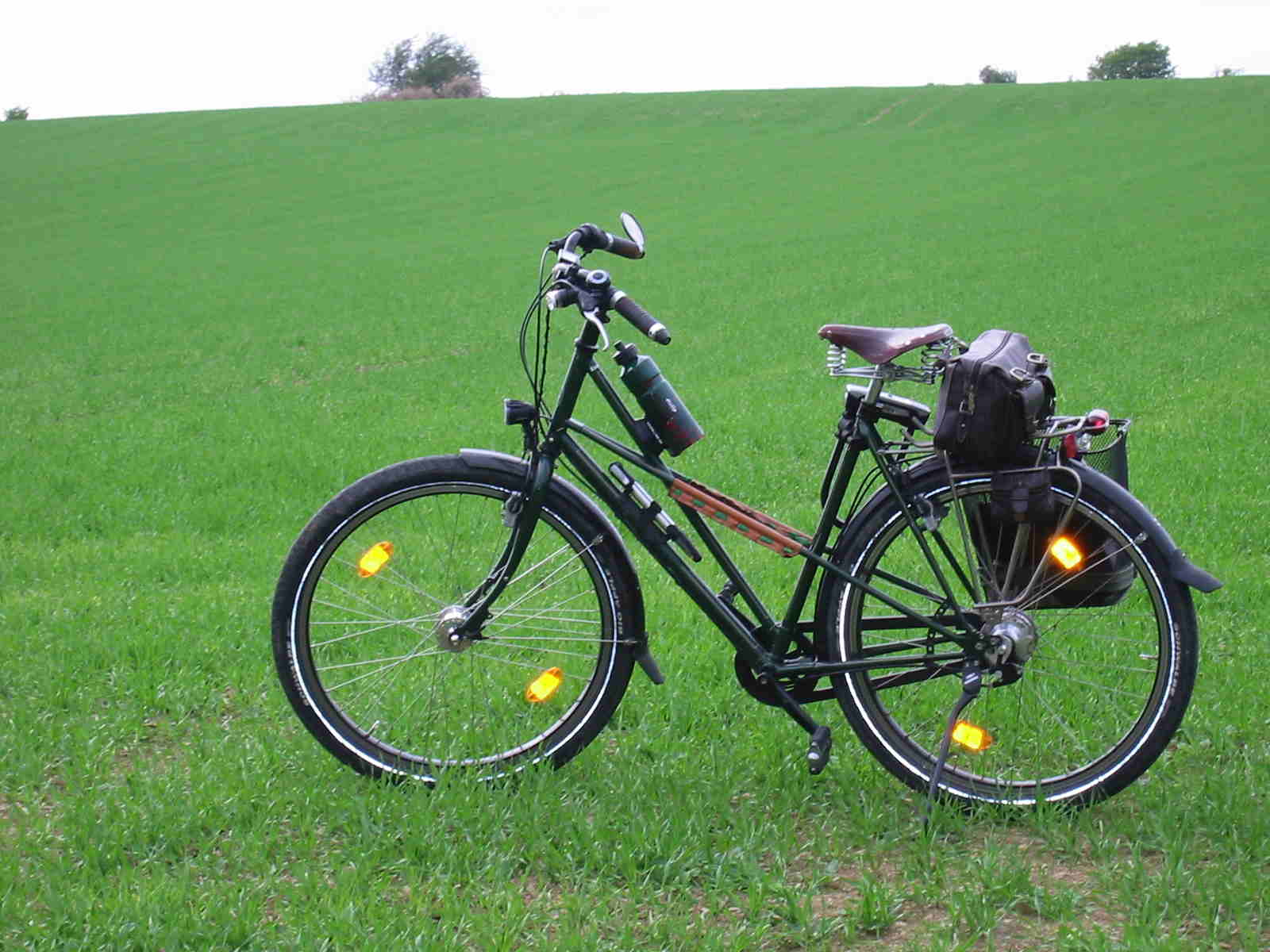TUBUS COSMO REVIEW
AFTER TWO YEARS
by Andre Jute
I've had really good luck with my rear racks. On three occasions ali racks were crumpled by carelessly driven Range Rovers, and the bikes were straight. So I've come to consider a rack a consumptible , disposable item, something like a chain or a chainring. All the same, the bright spots that my fave Basil Cardiff pannier baskets wore on the ali racks irritated me, and even the best racks these days have politically correct powder coating that just doesn't last like environment-wrecking hard duco.
A titanium rack, custom made if not found, seemed indicated. Thing is, I know quite a few techno-freak cyclists, engineers who cycle, even specialist metallurgists, and I couldn't find one with a titanium bike for any length of time who hadn't suffered a breakage. Also, from motor racing practice, where titanium space frames were once the highest state of the art, I know that those pipes and particularly their joints fatigue and part on a distressingly short cycle. Truth is, I'm amazed that ti is so widely used in aero practice.
So then I looked at stainless, and eventually bought a Tubus Cosmo. Now, tourers on adapted road bikes may have a different opinion, but I'm a utility/recreational cyclist with, beyond my own rather too corporeal presence, light requirements. Six bottles of wine for a couple of kilometres, that sort of thing. It may be that Tubus designed the Cosmo for the PBP, sacrificing utility for low weight. It's pretty narrow, it light weight also means light construction, in that I don't think those pipe walls are adequately thick to resist abrasion, and the kit comes without some of the necessary fittings, which I thought simply cheap on the part of Tubus but may be done to make their rack look good on the scales. The fitting kit, which may be necessary even on a 26" bike, is an irritating extra cost, and with the carriage, just about the price of a perfectly serviceable ali or steel rack at the LBS...
With this light weight comes a requirement for 3D triangulation if the rack is not to collapse at the first bump. So the Tubus designers ran the lower rail into the centreline of the bike at an angle towards the back. This makes it difficult to get the hooks of panniers onto the rail under the overhang of the top rail. There is also a hoop which you can attach nothing to but offers the structure further triangulation. It would have been better to design in slightly heavier wall tubing with, from the beginning, the aim that the purchaser should be able to attach something to every tube, and easily.
Though I'm not impressed with the apparent aim and design of the Tubus Cosmos, and the marketing stinks in making you pay extra for necessary distancing pieces and in not supplying all the necessary bolts and nuts, it must be said that once you have the Cosmos fitted it is rock solid, and the irritation quotient of the overhanging top rail depends on how often you take your panniers off. I keep a single Basil Cardiff pannier basket on the bike almost all the time, and on the other side occasionally fit a briefcase with hooks adapted to work with the overhanging top rail. But a tourer who wants to take his panniers off daily or more often will soon curse the Tubus designer for his incompetence or carelessness or trendiness, whatever inspired the abomination of that angled lower rail. I've learned to live with it, but, as I say, my requirements are pretty light compared to most Thorn owners'.
Tubus Cosmos:
For: Prestige, stainless so theoretically everlasting, lightweight, rock solid
Against: Poorly engineered, thin tubing will abrade fast, poorly designed with top rail overhanging lower rail making it difficult to fit and remove panniers, incomplete kit, overpriced, looks like painted ali, too sort for any big bike, old-fashioned and unnecessarily narrow design makes the Cosmos less useful than it should be, too twee and trendy for its own good
Copyright ©2012 Andre Jute
***
Further to Dan's remarks about protecting the rack from abrasion:
My fave Basil pannier baskets don't have a lower hook so I tie them on with my old webbing belts from my air force days, or with dayglo belts for extra visibility.
For protection against wire hooks and at interface points between basket mesh and rack lower down, I wrap the rack with a length of velcro in strategic places. Since I would be carrying these short lengths of velcro in the toolkit anyway, wrapping them around the rack is a saving. Not as tidy as Dan's stainless tape, but practical and proven over several years now (none of the velcro has ever worn through, making it tougher than limp modern powder-coats).
Dan's bikes always look like they're straight off the floor of a bike show, every addition he makes integrated like an OEM high$$$ extra...
The Cosmos isn't quite as toylike as it seems in this photograph; the Utopia Kranich on which I have it fitted is over 2m long, and those 60x622 balloon tyres are three-quarters of a meter high... But it is definitely on the small size for a serious touring rack.
